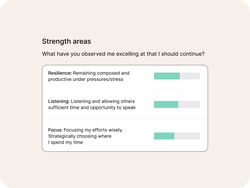
Article
360° reviews can seem daunting at first, especially if you’re accustomed to traditional performance reviews. In this article, we clarify the differences between the two styles of review and the benefits of the 360° review. We’ve also included a simple 360° review template to help you get started.
To be clear, this article is not going to condemn the performance review. There is space for both the 360° review and performance review in the workplace. However, it’s important to use them appropriately because their process, purpose, and results are different.
In practical terms, the difference between performance feedback and 360 feedback is the intention, audience, and consequences.
Chloe Hamman
Director of People Science at Culture Amp
Performance feedback is:
360 feedback is:
To a newcomer, the 360° approach can seem abstract or even a little chaotic. How are you supposed to keep track of all the information you receive, let alone consolidate it into effective and actionable feedback?
You simply need to have a clear structure and robust template before you start the 360° review. That way, you can keep track of all the data and feed it back to the reviewee effectively.
In the next section, we'll share the 360° review template we developed to simplify this process. It’s short and direct, so there won’t be hundreds of notes to collate. Moreover, a large section is multiple-choice, making it easy to see correlations in the feedback.
Take the time to provide an introduction to the person providing feedback on a 360 review. Use the introduction below for inspiration.
This 360 is used to measure the personal development of [employee name] to enable them to grow. We would like you to answer the questions regarding [employee name] based on your own personal experience of working and interacting with him/her/them.
Your feedback will be used to help [employee name] understand the key things they are doing well, and the key things they should focus on to make themselves, their team, and organization more successful.
Please take the time to answer honestly. Consider where he/she/they could improve and provide details where he/she/they excel. We would like a holistic review of [employee] name and genuine, contextual examples are of utmost importance.
Most of the questions in an easy-to-use 360° review are open-ended or multiple choice. Rating scales used in performance reviews must be chosen with care and are generally not needed in the context of a 360° review.
Clarify the name and role of the person who is receiving feedback and the person who is giving feedback. The three sections that follow form the core of a 360° review. You'll notice that the review starts with open feedback focused on success, and then leads into multiple-choice based on strengths. This primes the reviewer and the receiver to focus on the positive.
What is the one way [employee name] supports you and your team to succeed?
This is an open-text question. Here, you would direct the reviewer to provide one character trait that [employee name] exemplifies that supports them. You would also ask them to provide at least one real-life example.
What does [employee name] excel at and should continue to demonstrate?
Please select three answers. Please provide examples for each of your answers.*
Where does [employee name] have the opportunity to improve to make real, impactful differences?
Please select three answers. Please provide examples for each of your answers.*
*These are just five examples of the options that Culture Amp offers in our 360° review template.
360° reviews are a valuable tool for tracking the growth of employees, as well as ensuring they continue to progress and better themselves. However, to avoid data overload, it’s essential that you have a clear process and template in place before you get started. We hope our template has started you off on the right foot.

Supercharge manager and individual development with templated, action‑oriented 180° and 360° feedback surveys that pinpoint critical skill gaps.